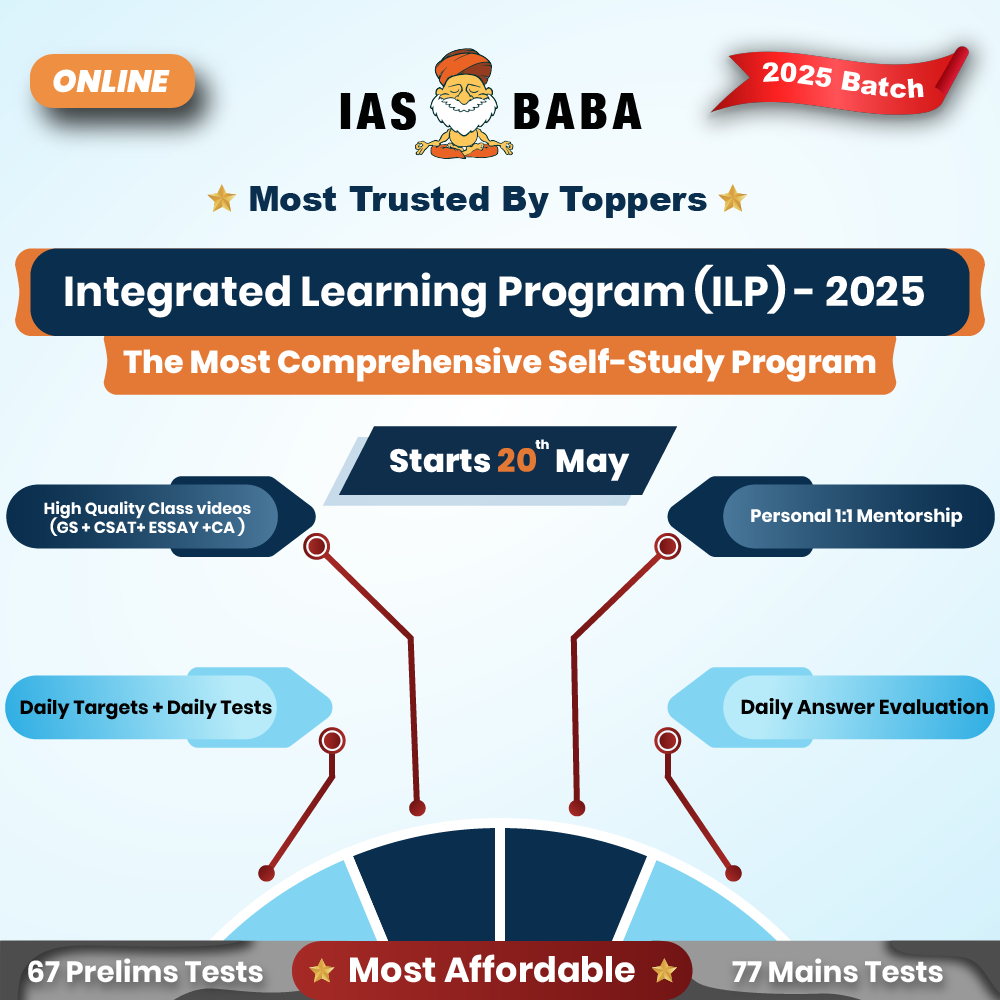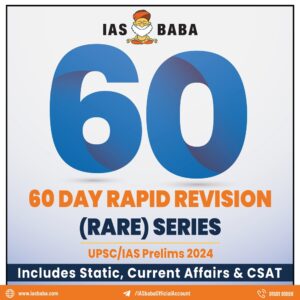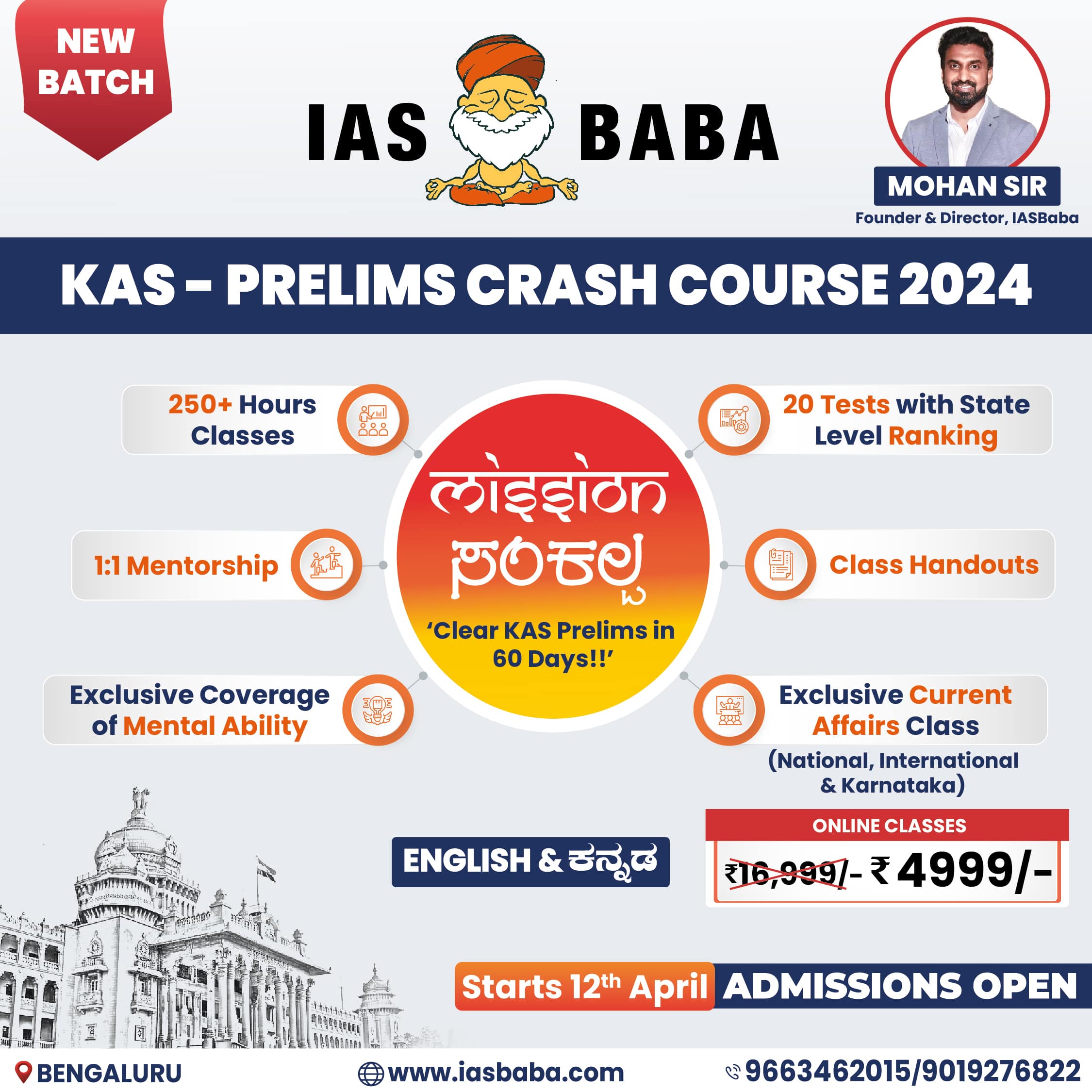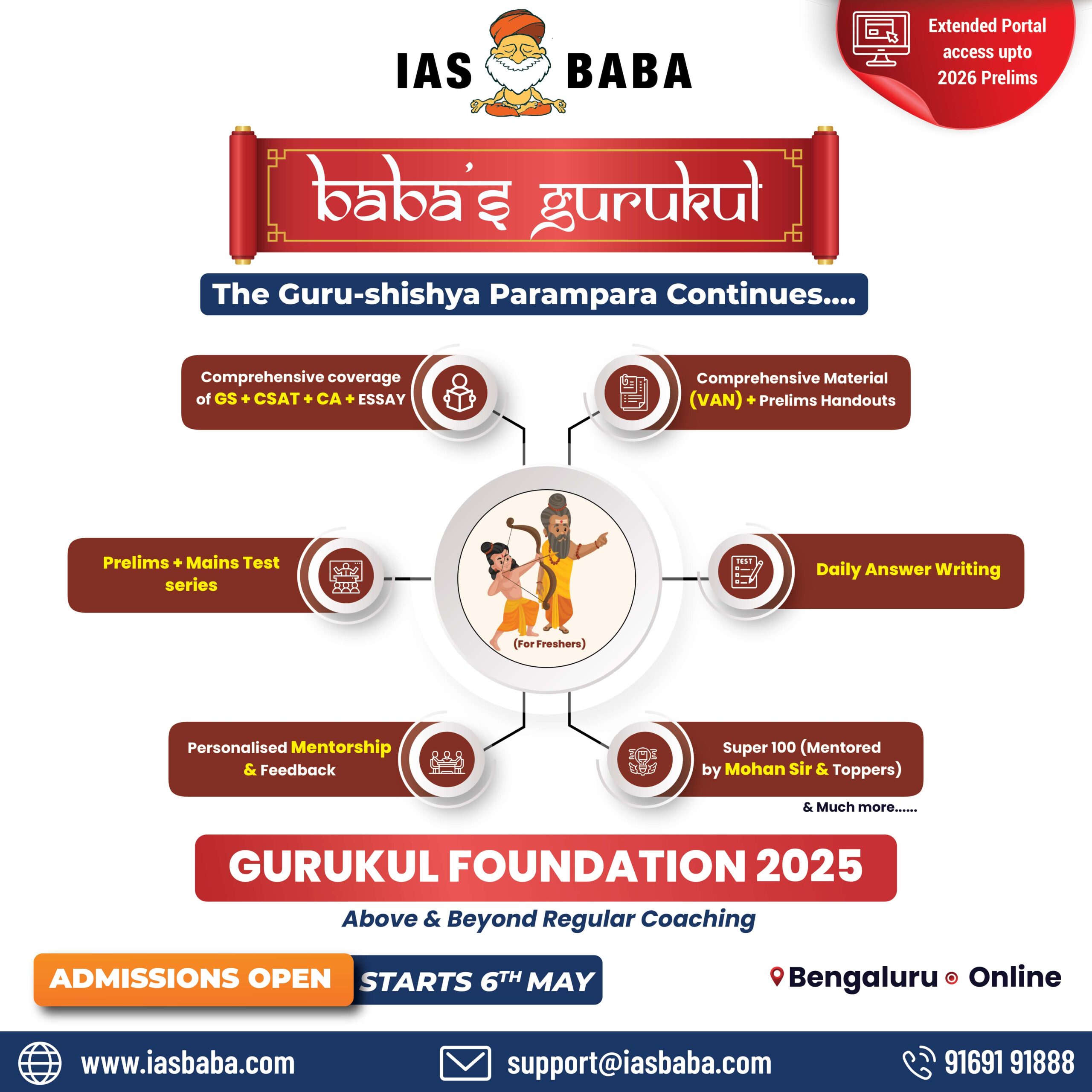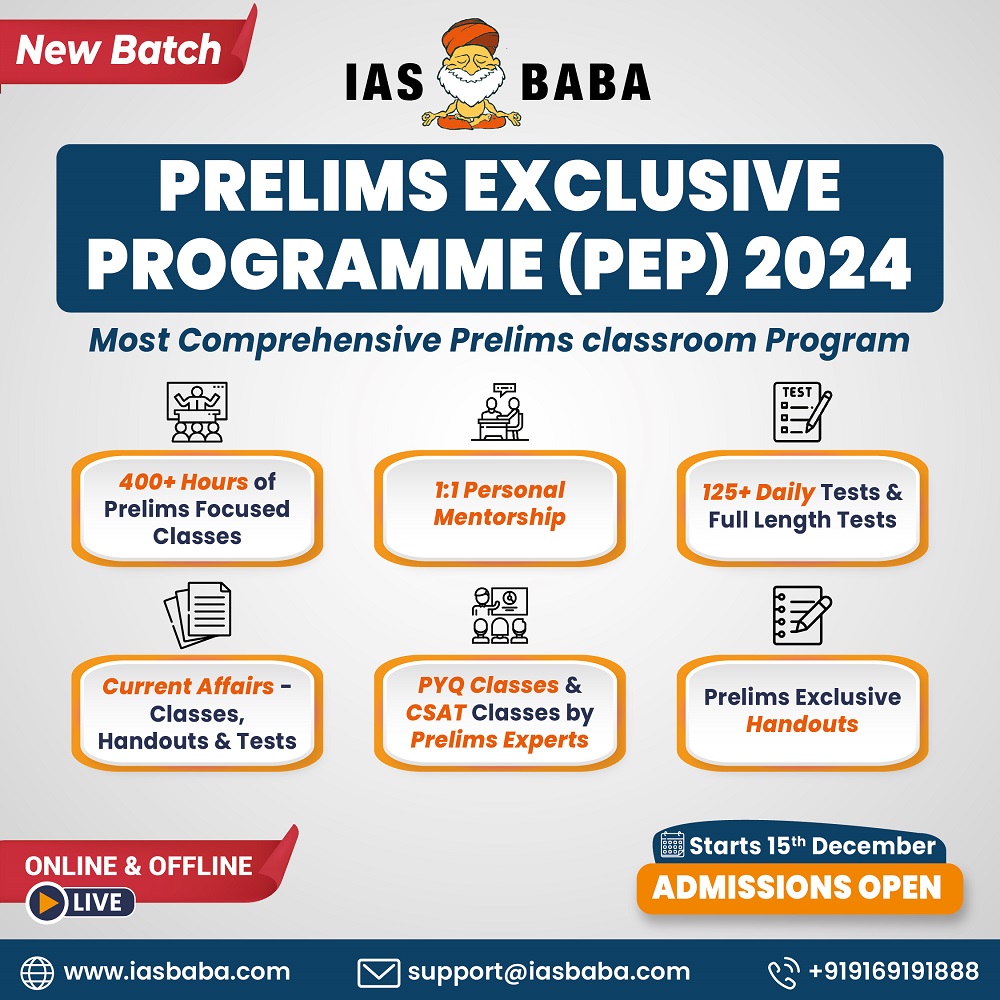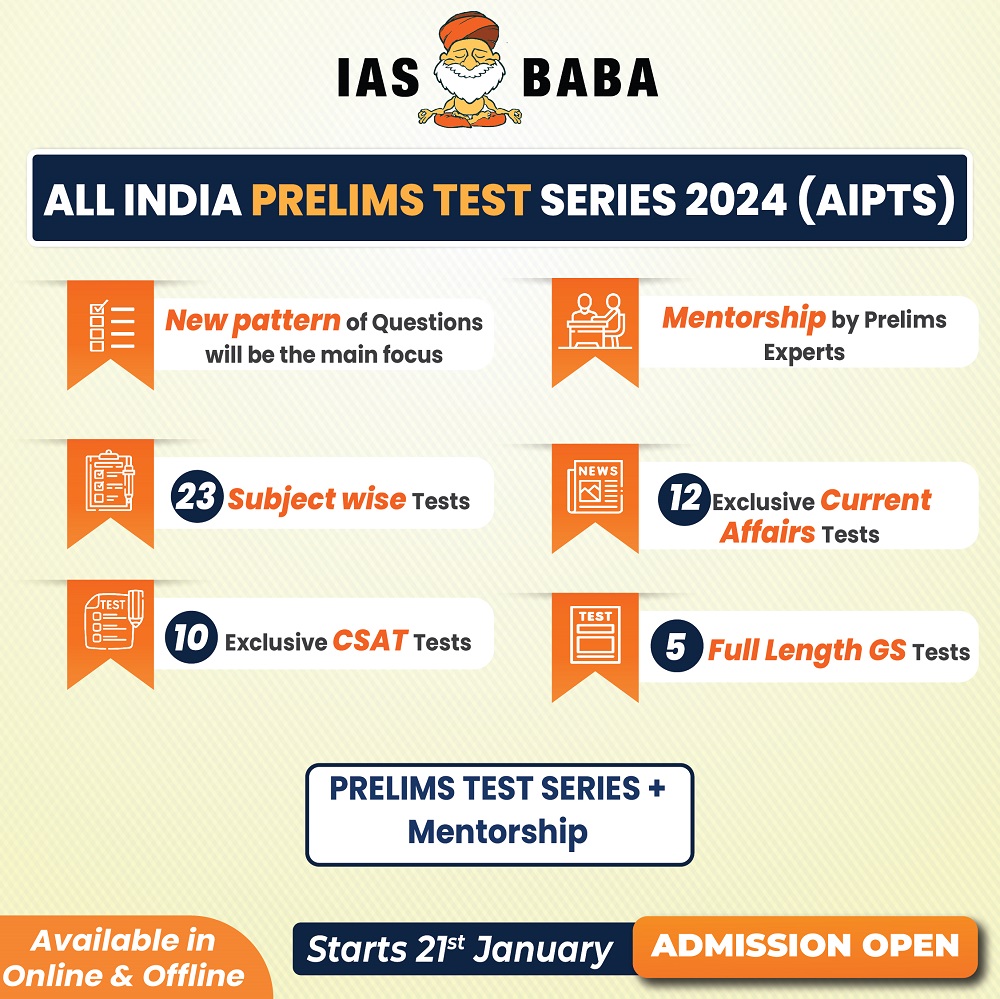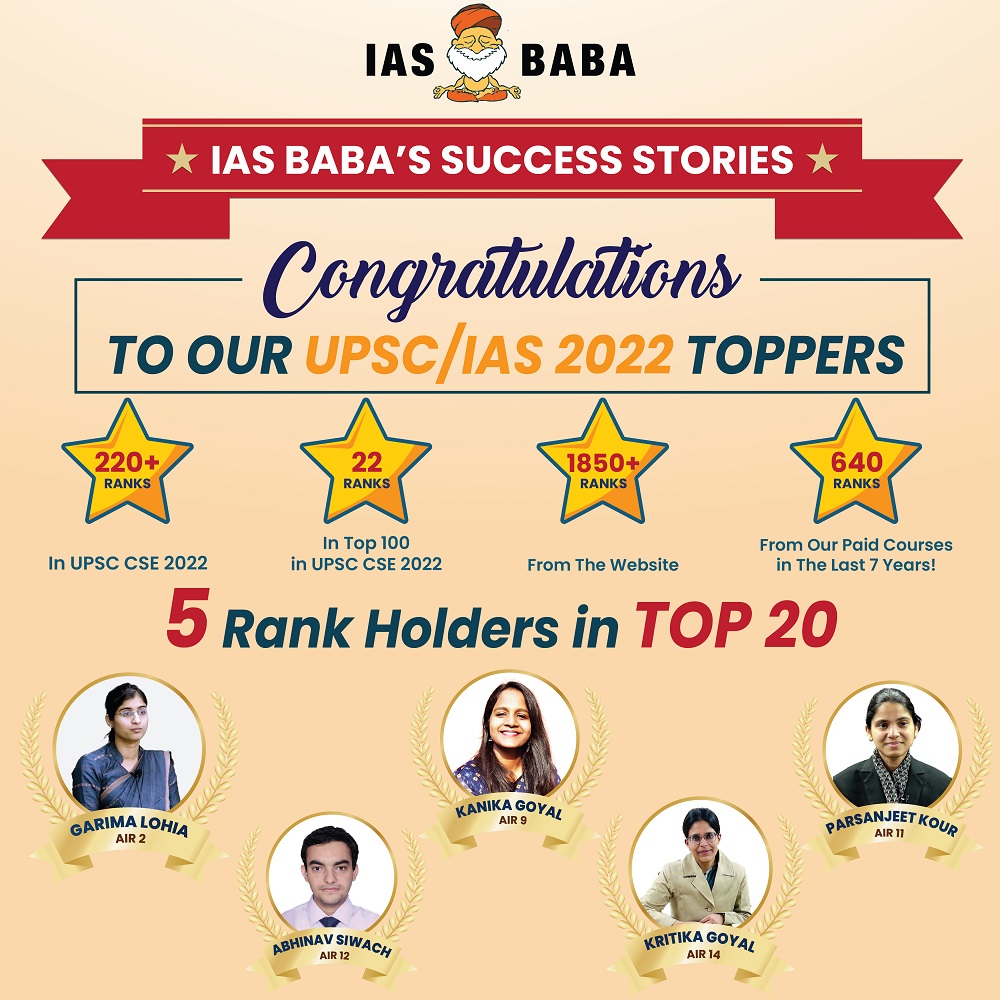IASbaba's Daily Current Affairs Analysis
Archives
(PRELIMS & MAINS Focus)
Syllabus
- Prelims –Important Institutions
Context: Recently, the Indian Meteorological Department issued an orange alert for rain in various parts of the country.
Background:-
- The Indian Meteorological Department issued an orange alert for rain in Uttarakhand, Himachal Pradesh, Western Uttar Pradesh, Eastern Rajasthan, Chhattisgarh, Vidarbha and Konkan.
- The water level of the rivers and drains has increased.
- The administration appealed to the people not to go near the banks of the rivers and drains.
About Indian Meteorological Department:-
- Established: 1875.
- Ministry: Ministry of Earth Sciences.
- IMD Headquarters: New Delhi.
- It is the National Meteorological Service of the country.
- It is the principal government agency in all matters relating to meteorology and allied subjects.
Objectives:-
- To take meteorological observations and provide current and forecast meteorological information for optimum operation of weather-sensitive activities like agriculture, irrigation, shipping, etc.
- To warn against severe weather phenomena tropical cyclones, duststorms, heavy rains and snow, cold and heat waves,, which cause the destruction of life and property.
- To conduct and promote research in meteorology and allied disciplines.
- To provide meteorological statistics required for agriculture, water resource management, industries, oil exploration and other nation-building activities.
The IMD uses four colour codes:-
- Green (All is well): No advisory is issued. (UPSC CSE: Colour Coded Weather Warning)
- Yellow (Be Aware): Yellow indicates severely bad weather spanning several days.
- Orange/Amber (Be prepared): The orange alert is issued as a warning of extremely bad weather with the potential of disruption in commute with road and rail closures, and interruption of power supply.
- Red (Take Action): When extremely bad weather conditions are certainly going to disrupt travel and power and have significant risk to life, the red alert is issued.
MUST READ: The India Meteorological Department (IMD) may introduce new monsoon models
SOURCE: AIR
PREVIOUS YEAR QUESTIONS
Q.1) Consider the following : (2023)
- Aerosols
- Foam agents
- Fire retardants
- Lubricants
In the making of how many of the above are hydrofluorocarbons used?
- Only one
- Only two
- Only three
- All four
Q.2) Consider the following statements: (2022)
- High clouds primarily reflect solar radiation and cool the surface of the Earth.
- Low clouds have a high absorption of infrared radiation emanating from the Earth’s surface and thus cause a warming effect.
Which of the statements given above is/are correct?
- 1 only
- 2 only
- Both 1 and 2
- Neither 1 nor 2
Syllabus
- Prelims – Important Awards
Context: The Ministry of Youth Affairs and Sports invited nominations for Tenzing Norgay National Adventure Award-TANNA 2022.
About Tenzing Norgay National Adventure Award-TANNA :-
- Tenzing Norgay National Adventure Awards are given every year.
- First awarded: 1994.
- Ministry: Ministry of Youth Affairs and Sports.
- The award is named after Tenzing Norgay. (UPSC CSE: Rural Sports in India)
- Tenzing Norgay: one of the first two individuals to reach the summit of Mount Everest along with Edmund Hillary in 1953.
Objectives
- To recognize the achievements of the person in the field of adventure.
- To encourage young people to develop the spirit of endurance, risk-taking, cooperative teamwork, and quick, ready, and effective reflexes in challenging situations.
- To provide incentives to young people for getting exposed to adventure activities.
Eligibility
- A person should have excellent performance and outstanding qualities of leadership, a sense of adventure discipline and continuous achievement in one particular field of adventure Land, Air or Water (Sea).
- The award may be given posthumously if such an occasion arises.
Exclusions
- No award will be conferred for a second time to the same person under the same category.
- The government of India may cancel or annul the award to any person under circumstances, which, in the opinion of the Government, might render such person unworthy of the award.
Decoration
- The award consists of a Bronze statuette, a certificate, a blazer with a silken tie/a saree and an award money of Rs. 15 Lakhs.
- The Awards are presented to the winners along with Arjuna Awards by the Government of India.
- Arjuna Awards: they are given for Outstanding Performance in Sports and Games.
- It is the second-highest sporting honour in India, the highest being the Major Dhyan Chand Khel Ratna Award.
No. of Awardees
- Awards can be given in four categories namely:
- Land Adventure, Water (Sea) Adventure, Air Adventure and Life Time Achievement.
- Ordinarily not more than one Award will be made in each category.
- The Ministry may increase the number of awards in a particular year with the approval of the Hon’ble Minister of Youth Affairs and Sports.
MUST READ: Golden Globe Awards.
SOURCE: AIR
PREVIOUS YEAR QUESTIONS
Q.1) Consider the following pairs with regard to sports awards : (2023)
- Major Dhyan Chand: For the most Khel Ratna Award spectacular and outstanding performance by a sportsperson over the period of the last four years.
- Arjuna Award: For the lifetime achievement of a sportsperson.
- Dronacharya Award: To honour eminent coaches who have successfully trained sportspersons or teams.
- Rashtriya Khel: To recognize the Protsahan Puraskar contribution made by
sportspersons even after their retirement.
How many of the above pairs are correctly matched?
- Only one
- Only two
- Only three
- All four
Q.2) Consider the following statements in respect of the 44th Chess Olympiad, 2022: (2023)
- It was the first time that Chess Olympiad was held in India.
- The official mascot was named Thambi’.
- The trophy for the winning team in the open section is the Vera Menchik Cup.
- The trophy for the winning team in the women’s section is the Hamilton-Russell Cup. ·
How many of the statements given above are correct?
- Only one
- Only two
- Only three
- All four
Syllabus
- Prelims – International Relations
Context: Recently, Egypt’s ‘Order of the Nile’ was conferred to Prime Minister Modi.
Background:-
- Prime Minister Narendra Modi received the ‘Order of the Nile’ award.
- It is the Egypt’s highest state honour.
- Prime Minister Modi is on a two-day state visit to Egypt.
- He also visited the historic 11th-century Al-Hakim Mosque in Cairo, which was restored with the help of India’s Dawoodi Bohra community.
- Dawoodi Bohras: a religious denomination within the Islamic branch of Shia Islam.
- Their largest numbers reside in India, Pakistan, Yemen, East Africa, and the Middle East.
About Order of the Nile:-
- It is Egypt’s highest state honour. (UPSC MAINS: collaboration between India and Egypt)
- Instituted: in 1915.
- Presented by: State of Egypt.
- It is conferred upon Heads of state, Crown Princes, and Vice-Presidents who offer Egypt or humanity invaluable services.
- Decoration: it is a pure gold collar consisting of three-square gold units comprising Pharaonic symbols.
- Pharaonic symbols: these were numerous symbols in the life of ancient Egyptians and varied in their symbols, rituals, and use.
MUST READ: India-Africa: Challenges & Way Ahead
SOURCE: THE INDIAN EXPRESS
PREVIOUS YEAR QUESTIONS
Q.1) Consider the following statements (2020)
- The value of Indo-Sri Lanka Trade has consistently increased in the last decade.
- Textile and textile articles constitute an important item of trade between India and Bangladesh.
- In the last five years, Nepal has been the largest trading partner of India in South Asia.
Which of the statements given above is/are correct?
- 1 and 2 only
- 2 only
- 3 only
- 1,2, and 3
Q.2) The term “two-state solution” is sometimes mentioned in the news in the context of the affairs of (2022)
- China
- Israel
- Iraq
- Yemen
Syllabus
- Prelims – Environment and Ecology
Context: Global Environment Facility (GEF) Council met in Brazil recently.
Background:-
- The Global Environment Facility (GEF) Council met in Brazil on June 26, 2023.
- The question of the funding needed to achieve the goals and targets of the Kunming-Montreal Global Biodiversity Framework was discussed at the GEF Council meeting.
- GEF was tasked to find funds for the implementation of the framework adopted at the 15th Conference of the Parties (COP15) to the Convention on Biological Diversity (CBD).
- At COP15, it was decided that a new trust fund, the Global Biodiversity Framework Fund (GBF), would be put in place to run the projects under the framework.
- Under Target 19 of the GBF, members have to generate at least $200 billion per year by 2030 for biodiversity.
About Global Environment Facility (GEF) Council:-
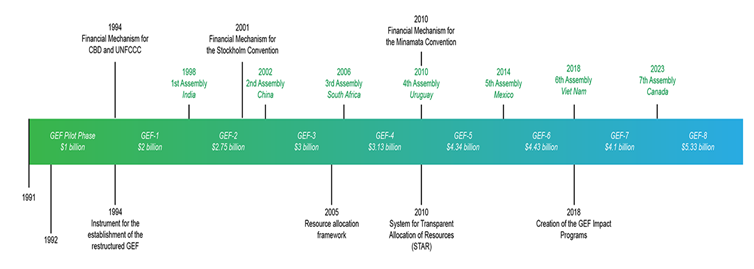
IMAGE SOURCE: thegef.org
- The Global Environment Facility (GEF) is a partnership for international cooperation.
- HQ: Washington DC, United States.
- Established: in 1991.
- It was set up as a fund under World Bank.
- World Bank: it is an international financial institution that provides loans and grants to the governments of low- and middle-income countries for the purpose of pursuing capital projects.
- Restructured: in 1994.
- 1992: at the Rio Earth Summit, the GEF was restructured and moved out of the World Bank system to become a permanent, separate institution.
- Since 1994, however, the World Bank has served as the Trustee of the GEF Trust Fund.
- Rio Earth Summit: it was a major United Nations conference held in Rio de Janeiro (Brazil) in 1992.
- It highlighted the impact of human socio-economic activities on the environment.
- Members: 183 countries work together with international institutions, civil society organizations and the private sector, to address global environmental issues.
- Funding:-
- GEF funds are available to developing countries seeking to meet the objectives of international environmental agreements.
- Support is provided to government agencies, civil society organizations, private sector companies, research institutions, and other partners to implement projects and programs related to environmental conservation, protection, and renewal.
Structure:
- The GEF’s governing structure is organized around an Assembly, Council, Secretariat, 18 implementing agencies, a Scientific and Technical Advisory Panel, and the Independent Evaluation Office.
GEF Council:-
- The Council, the GEF’s main governing body.
- It comprises 32 members appointed by constituencies of member countries.
GEF serves as a financial mechanism for :
- Convention on Biological Diversity (CBD)
- Signed: 5 June 1992 – 4 June 1993.
- Effective from 1993.
- It is the international legal instrument for “the conservation of biological diversity, the sustainable use of its components and the fair and equitable sharing of the benefits.
- United Nations Framework Convention on Climate Change (UNFCCC)
- Signed:1992-1993.
- Effective from 1994.
- It was adopted in 1992 with the ultimate aim of preventing dangerous human interference with the climate system.
- UN Convention to Combat Desertification (UNCCD)
- Signed: 14 October 1994 – 13 October 1995.
- Effective from 1996
- It was established in 1994 to protect and restore our land and ensure a safer, just, and more sustainable future.
- Stockholm Convention on Persistent Organic Pollutants (POPs)
- Signed:2001.
- Effective from 2004.
- It is an international environmental treaty that aims to eliminate or restrict the production and use of persistent organic pollutants (POPs).
- Minamata Convention on Mercury
- Signed: 2013.
- Effective from 2014.
- It is an international treaty designed to protect human health and the environment from anthropogenic emissions and releases of mercury and mercury compounds.
- Montreal Protocol on Substances that Deplete the Ozone Layer.
- Signed: 1987.
- Effective from 1989.
- It is a global agreement to protect the Earth’s ozone layer by phasing out the chemicals that deplete it.
GEF and India:
- India is a founder member of GEF.
- It is both a donor and recipient of GEF funds.
- India represents the GEF South Asia Constituency (including, Bangladesh, Bhutan, Maldives, Nepal and Sri Lanka) in the GEF Council.
- GEF Political Focal Point: Department of Economic Affairs (DEA).
- It is responsible for issues related to GEF governance, including policies and decisions, as well as relations between member countries and the GEF Council and Assembly.
- GEF Operational Focal Point (OFP): The Ministry of Environment, Forest and Climate Change (MoEFCC).
MUST READ: Kunming-Montreal Global Biodiversity Framework
SOURCE: DOWN TO EARTH
PREVIOUS YEAR QUESTIONS
Q.1) Consider the following : (2023)
- Aerosols
- Foam agents
- Fire retardants
- Lubricants
In the making of how many of the above are hydrofluorocarbons used?
- Only one
- Only two
- Only three
- All four
Q.2) Climate Action Tracker” which monitors the emission reduction pledges of different countries is a :
- Database created by a coalition of research organisations.
- Wing of “International Panel of Climate Change”.
- Committee under “United Nations Framework Convention on Climate Change”.
- Agency promoted and financed by United Nations Environment Programme and World Bank.
Syllabus
- Prelims –Science and Technology
Context: Recent studies by the Indian Institute of Astrophysics (IIA) have given a clearer picture of how the sun’s magnetic field influences interplanetary magnetic space.
About the study and its findings:-
- With the help of this study, scientists are now one step closer to identifying the source of solar mean magnetic field (SMMF).
- SMMF: is the mean value of the line-of-sight (LOS) component of the solar vector magnetic field averaged over the visible hemisphere as well as its relationship with Interplanetary Magnetic Field (IMF).
- IMF: it is the extension of the coronal magnetic field dragged by the solar wind to the interplanetary space.
- LOS: it is the direct path between two points.
- Scientists have found a very good similarity between the SMMF at chromospheric heights and the SMMF at photospheric heights.
- The value of chromospheric SMMF is lower than the photospheric SMMF.
- This suggests that the primordial magnetic field inside the sun could be a source of the SMMF.
- Data Technique:-
- They calculated and analysed the SMMF using magnetic field measurements at the chromosphere, in conjunction with that photospheric measurements.
- Chromosphere: a reddish gaseous layer immediately above the photosphere of the sun or another star.
- Photosphere: the visible surface of the Sun.
- These electrical currents are generated by the flow of hot, ionised gases in the sun’s convection zone.
- Sun’s convection zone: it is the outermost layer of the interior portion of the sun.
- This layer extends to about 200,000 km up to the
Solar Mean Magnetic Field (SMMF)
- The SMMF represents the mean value of the line-of-sight component of the solar vector magnetic field averaged over the visible hemisphere of the sun.
- The sun contains the corona, the photosphere, and the chromosphere with the magnetic field generated by electrical currents acting as a magnetic dynamo inside the sun.
- Corona: the outer shell of the sun’s atmosphere.
- Significance:-
- So far, the studies on the SMMF have mostly been confined to the magnetic field measurements at the photosphere.
- Understanding the source of the SMMF and its driving parameters could help us understand how the SMMF affects the IMF.
About the Indian Institute of Astrophysics (IIA):-
- The Indian Institute of Astrophysics is a premier institute devoted to research in astronomy, astrophysics and related physics.
- Historical Background:-
- It traces its origins back to an observatory set up in 1786 at Madras.
- From the year 1792 began to formally function at its Nungambakkam premises as the Madras Observatory.
- 1899: the observatory moved to Kodaikanal.
- 1971: the Kodaikanal Observatory became an autonomous society, and came to be know as the Indian Institute of Astrophysics.
- HQ: Bengaluru.
- Ministry: Department of Science and Technology, Ministry of Science and Technology.
- Funding: funded by the Department of Science and Technology.
- Main observing facilities: Kodaikanal, Kavalur, Gauribidanur and Hanle.
- The Vainu Bappu Observatory at Kavalur has been the main optical observatory of the Institute for nighttime astronomy since the late 1960s.
- There are several telescopes in operation here, the foremost among these being the 2.34-metre Vainu Bappu Telescope.
- The Kodaikanal Observatory has for over a century been the principal centre of activity in observational solar and atmospheric physics. (UPSC CSE: Gaganyaan)
MUST READ: Indian Space Association
SOURCE: THE HINDU
PREVIOUS YEAR QUESTIONS
Q.1) Which one of the following countries has its own Satellite Navigation System? (2023)
- Australia
- Canada
- Israel
- Japan
Q.2) Consider the following pairs : (2023)
Objects in space Description
- Cepheids Giant clouds of dust and gas in space.
- Nebulae Stars which brighten and dim periodically.
- Pulsars Neutron stars are formed when massive stars run out of fuel and collapse.
How many of the above pairs are correctly matched?
- Only one
- Only two
- All three
- None
Syllabus
- Prelims – Important Personalities
Context: Rani Durgavati Gaurav Yatra’ concluded in Madhya Pradesh recently.
Background:-
- The Shivraj Singh Chouhan-led BJP government in Madhya Pradesh launched the six-day Rani Durgavati Gaurav Yatra.
About Rani Durgavati:-
- Rani Durgavati was born in 1524 in the Chandela dynasty in present-day Uttar Pradesh, near the border with Madhya Pradesh.
- Her father was Raja Salbahan of Ratha known for the famous Khajuraho temples.
- She married Dalpat Shah, of the kingdom of Garha-Katanga.
- However, she became a widow after a few years and took charge of ruling the kingdom.
Battle with Mughals:-
- During the mid-16th century, Akbar led the Mughal Empire’s expansion in India.
- The Mughal governor Asaf Khan launched an attack on Garha-Katanga.
- During the prolonged fighting, Rani Durgavati was struck by arrows and, rather than surrendering, is believed to have stabbed herself with her dagger.
Rani Durgavati’s leadership
- Rani Durgavati managed the affairs of the kingdom for 16 years, maintaining trade relations and undertaking public works.
- Abul Fazl, the court historian of Akbar who chronicled these years in Akbarnama, described Durgavati as a combination of “beauty, grace and manlike courage and bravery”.
Legacy of Rani Durgavati
- Political symbolism: Rani Durgavati is hailed as a patriotic ruler and defender of culture, becoming a symbol of pride and honour.
- Rani Durgavati and her son Veer Narayan are well known for their connections to the Madan Mahal Fort in Jabalpur.
- In her honour, the University of Jabalpur was renamed Rani Durgavati Vishwavidyalaya by the Madhya Pradesh government in 1983.
- On June 24, 1988, the Indian government released a postage stamp in memory of her.
- The Durgavati Express (11449/11450) runs between Jabalpur Junction and Jammutawi and is named for the Queen.
- The third Inshore Patrol Vessel (IPV) of its kind, ICGS Rani Durgavati, was commissioned by the Indian Coast Guard on July 14, 2018.
SOURCE: The Hindu
PREVIOUS YEAR QUESTIONS
Q.1) Consider the following freedom fighters: (2022)
- Barindra Kumar Ghosh
- Jogesh Chandra Chatterjee
- Rash Behari Bose
Who of the above was/were actively associated with the Ghadar Party?
- 1 and 2
- 2 only
- 1 and 3
- 3 only
Q.2) Who among the following is associated with ‘Songs from Prison’, a translation of ancient Indian religious lyrics in English? (2021)
- Bal Gangadhar Tilak
- Jawaharlal Nehru
- Mohandas Karamchand Gandhi
- Sarojini Naidu
Lab-grown meat/Cell-cultivated chicken
Syllabus
- Mains – GS 3 (Science and Technology)
Context: Recently, two California-based companies were cleared to make and sell cell-cultivated chicken in the country.
About Cell-cultivated chicken:
- It’s meat grown from the cells of animals in steel tanks for human consumption.
- Though it’s known in the industry as cultivated meat, it’s sometimes called cultured meat, lab-grown meat or cell-based meat.
- The first country to approve the sale of alternative meat was Singapore in 2020.
- There are more than 150 companies around the world trying to develop these food products.
- They’re working on a variety of meats: chicken, beef, pork and lamb.
Process involved:

- To make cell-cultivated meat, the company isolates the cells that make up the meat (the meat that we consume).
- It starts with cells, which can come from a fertilized egg, a special bank of stored cells or tissue initially taken from a living animal.
- Then it is put in a setting where they have all the resources they need to grow and make more copies of themselves.
- These resources are typically nutrients, fats, carbohydrates, amino acids, the right temperature, etc.
- The ‘setting’ in which this process transpires is often a bioreactor (also known as a ‘cultivator’).
- A bioreactor is a sensor-fit device like a container that has been designed to support a particular biological environment.
- Once there are enough of these cells, which takes around two to three weeks, they resemble a mass of minced meat.
- Cells are triggered to turn into skeletal muscle, fat and connective tissues.
- After days or weeks, the cells are removed from the tanks and shaped into products such as nuggets.
Significance of cultured meat:
- Reduce environmental impact: It could vastly reduce the environmental impact of global meat production in the future.
- Reduce emissions: Emissions from conventional animal agriculture could be reduced.
- Uses less water: It uses much less land and water than livestock.
- Renewable energy: It can run on energy produced purely from renewable sources.
- Prevent animal slaughter: Cultivated meat helps save animal slaughter.
- Food accessibility: Provides food accessibility to the population living in under-developed and strife-torn areas.
- High in nutrients: Lab-grown meat is high in protein, vitamins, and minerals and can be lower in fat and cholesterol than conventional animal meat.
Challenges:
- Consumer acceptance: Perfectly substituting animal meat with alternative meat requires the latter to match the former’s taste, texture, and appearance, and cost.
- Researchers have achieved some success on these counts but it remains a work in progress, especially as more meats acquire alternative counterparts.
- Cost: The cost of cell-cultivated meat is expected to remain high in the near future.
- It may never be cost-competitive, while reports have also expressed concerns about the costs imposed by quality control, especially at scale.
- Huge resources required: For cultivation, researchers require high quality cells, a suitable growth-medium in which the cells can be cultured, plus other resources required to maintain the quality of the final product.
- A World Health Organization report on the food safety aspects of cell-based food noted several potential issues, such as microbial contamination at various points in the process, biological residues and by-products and scaffolding that some people might be allergic to.
Way Forward:
Although there are several potential issues, such as microbial contamination at various points in the process, biological residues and by-products and scaffolding that some people might be allergic to. But experts noted that conventional meat also carries risks, such as bacterial contamination before and during the slaughtering and packaging process.
Overall, these advances are the result of the global necessity to renovate our approaches to nutrition and health systems toward providing for both individual and planetary health.
Source: The Hindu
Syllabus
- Mains – GS 1 (Geography) and GS 3 (Disaster Management)
Context: Recently, India and Pakistan have been affected due to flash floods.
About Flash Floods:
- A flash flood is a rapid flooding of geomorphic low-lying areas: washes, rivers, dry lakes and basins.
- It may be caused by heavy rain associated with a severe thunderstorm, hurricane, tropical storm, or meltwater from ice or snow flowing over ice sheets or snowfields.
Status of Floods in India: National Disaster Response Force (NDRF) Report

Source: researchgate.net
- 40 million hectares (10% of the land mass) in India is prone to floods.
- On an average every year, 5 million hectares of land is affected, 1600 lives are lost and more than Rs. 1,800 crores is incurred.
- Between 1970 and 2004, 3 floods occurred per year on an average. However, between 2005 and 2019, the yearly average rose to 11. 19 districts were affected annually on an average until 2005. After 2005, the number jumped to 55.
- 2017 analysis suggests that 4.48 million Indians are exposed to riverine floods, the highest in the world.
Causes of flooding in India:
Physiological Reasons:
- Heavy precipitation: Heavy rainfall is one of the major reasons for the flood in India.
- Such effect can be seen in the West Coast region of the Western Ghat, Assam and sub-Himalayan West Bengal.
- The meandering tendency of river-flow: The tendency to meander or change the course within a specific boundary of rivers in the flat terrains also causes a flood in the meandering regions like the lower reaches of the Brahmaputra and Gangetic plains.
- Silting in Delta areas: The deposition of silt on the river-mouths by the sea tides deteriorates the discharging capacity of rivers which causes a flood in that region.
- Earthquake and Landslide: Sometimes it has been found that the river changes its course after natural calamities like earthquake, landslide which causes a flood in the same region.
- Such instances can be found in the mountain of hilly region states like Jammu and Kashmir, Himachal Pradesh, and Uttarakhand etc.
- Obstruction of free-flow of rivers: Roads, embankments, railway lines, canals etc. obstruct the free flow of rivers leading to floods in the area.
- Cloudburst: Cloud bursts lead to a high amount of rainfall within a short time leading to flash floods.
- Flash flood generally occurs in the Himalayan region.
Man-made Reasons:
- Continued settlement in flood-prone areas: Floodplains of several rivers, especially in the northern plains like Kosi, Ghaghara, Gandak, Sarayu etc are flooded every year.
- Yet, these areas have been settled by people.
- This has led to recurring losses in the face of floods, especially in the Assam and Bihar plains.
- Encroachment over natural bodies: The destruction of natural wetlands including marshes and lakes has led to the blocking of areas that had earlier served as water sinks.
- This is the primary reason behind Chennai floods.
- Rapid and unplanned urbanisation: Construction of houses in a haphazard manner without getting plans approved has led to the washing away of several buildings during flash floods due to cloudbursts in the Himalayan region.
- Nature’s destruction: With increasing deforestation especially along coastal areas and river banks, the first line of defence against floods has been removed.
- This is the reason that cyclone caused floods result in severe destruction along the coasts.
Consequences of Flash floods:
- Human Loss and Property Loss: Every year, millions of people become homeless and washed away due to floods.
- Spread of Communicable Diseases: Waterborne diseases like cholera, typhoid fever, hepatitis, and leptospirosis spread in flood-affected areas.
- Floods also lead to vector-borne diseases, transmitted through parasites and pathogens such as a mosquito.
- As a result, the health of flood victims deteriorates.
- Destruction of Crops: Every year, floods destroy a large number of crops.
- Loss of Livestock: Like humans, livestock also get displaced during floods and die due to the loss of their habitats.
- Disruption of Communication Link and Transportation: Flood causes damage to transportation links such as bridges, rail, power plants etc., thus causing communication disruption in those areas.
- Economic and Social Disruption: The economy comes to a standstill as people are forced to move to another place, and revival of this situation takes time.
Preventive measures to the flooding problem:
- Improved flood warning systems: effective flood warning systems can help take timely action during natural calamities and can save lives.
- Pre-planning can significantly reduce the effects of floods, giving people time to migrate to safer locations and stock up essentials.
- Building flood-resilient housing systems: concreting floors can be very useful during floods. Houses should be water proofed and electric sockets should be placed at higher levels up the walls to reduce the chances of shocks.
- Constructing buildings above flood levels: buildings should be constructed a metre above from the ground to prevent flood damage and evacuation during floods.
- Create wetlands and encourage reforestation: creating more and more wetlands can help soak up excessive moisture since wetlands act as sponges.
- Wooded areas can also slow down heavy water flow, minimizing the effects of floods.
- Reforesting upstream regions can significantly reduce the effects of flood damage.
- Installing flood barriers: these are flood gates designed to prevent the area behind the barrier from flooding.
- They can also be kept around buildings to keep floodwaters outside the boundary created.
- Development of GIS: Geographical Information System (GIS) based National Database for disaster management.
- GIS is an effective tool for emergency responders to access information in terms of crucial parameters for disaster-affected areas.
Way Forward:
With growing climate change impacts, flooding in India is also all set to increase in magnitude and intensity. Thus, the need of the hour is to adopt the Sendai framework’s Disaster risk resilience approach in flood management in India along with NDMA guidelines.
Source: Indian Express
Practice MCQs
Q1) Consider the following statements
Statement-I: Tenzing Norgay National Adventure Award is awarded for scientific innovation.
Statement-II: Tenzing Norgay National Adventure Award is awarded by the Ministry of Youth Affairs and Sports.
Which one of the following is correct in respect of the above statements?
- Both Statement-I and Statement-II are correct and Statement-11 is the correct explanation for Statement-I
- Both Statement-I and Statement-II are correct and Statement-II is not the correct explanation for Statement-I
- Statement-I is correct but Statement-II is incorrect
- Statement-I is incorrect but Statement-II is correct
Q2) Consider the following statements
Statement-I: Rani Durgavati was born in the Chandela dynasty.
Statement-II: Rani Durgavati died fighting against the British.
Which one of the following is correct in respect of the above statements?
- Both Statement-I and Statement-II are correct and Statement-11 is the correct explanation for Statement-I
- Both Statement-I and Statement-II are correct and Statement-II is not the correct explanation for Statement-I
- Statement-I is correct but Statement-II is incorrect
- Statement-I is incorrect but Statement-II is correct
Q3) Consider the following statements
Statement-I: Global Environment Facility Council is under UNESCO.
Statement-II:Global Environment Facility was established in 1991.
Which one of the following is correct in respect of the above statements?
- Both Statement-I and Statement-II are correct and Statement-11 is the correct explanation for Statement-I
- Both Statement-I and Statement-II are correct and Statement-II is not the correct explanation for Statement-I
- Statement-I is correct but Statement-II is incorrect
- Statement-I is incorrect but Statement-II is correct
Comment the answers to the above questions in the comment section below!!
ANSWERS FOR ’ 27th June 2023 – Daily Practice MCQs’ will be updated along with tomorrow’s Daily Current Affairs.st
ANSWERS FOR 26th June – Daily Practice MCQs
Q.1) – d
Q.2) – a
Q.3) – c




